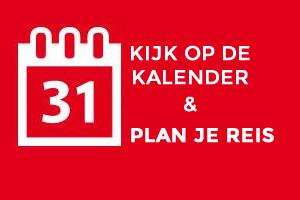Day 1 - Departure - Sochi
The flight is probably first to Moscow and than to Sochi where we sleep in a hotel along the Black Sea. If you arrive in time, you might want go for a swim.
Day 2 - Sochi - Tuapse
After breakfast, we start with a ride through Sochi. We visit the Olympic stadium and follow the formula one circuit. The road that we are following is located between famous mountains of Caucasus and the Black Sea. Towards Tuapse we drive on a paved road where we will encounter a lot of freight traffic. We have lunch in Tuapse and drive along mountains over the Shaumian pass. If we are on time you can swim in the Black Sea. It is a long first day driving and we will have dinner in Tuapse.
The Black Sea is fed by five rivers: the Danube, the Dnieper, the Dniester, the Don, and the Kuban. They provide an enormous amount of fresh water. Salty water enters from the Bosphorus. This difference means that the Black Sea has two faces: due to the higher specific gravity, the salt water from the Mediterranean Sea spreads over the entire bottom of the Black Sea. There is hardly any mixing with the surface water. That is why hardly any oxygen is supplied to the deeper layers. Below 150 meters, the Black Sea is a dead sea. After World War II, the underwater fauna disappeared partly due to pollution from the former Soviet Union.
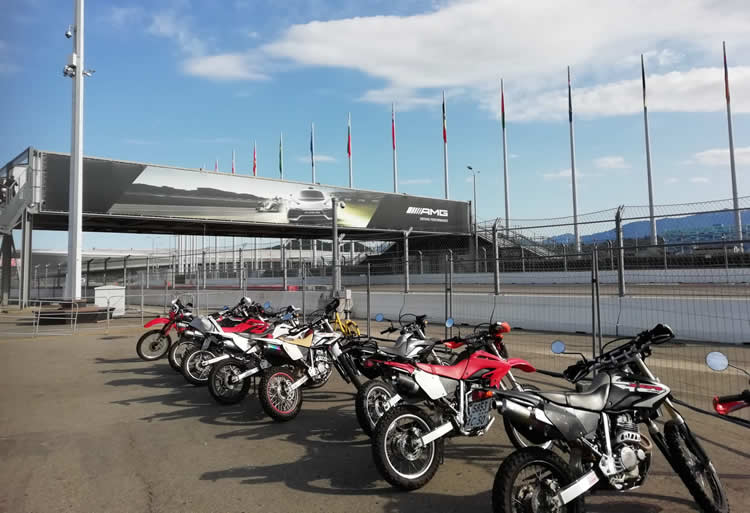
Day 3 - Tuapse - Kurdzhinovo
We will get up early in the morning and drive to Kurdzhinovo following a long and difficult road through the mountains. The first part we drive over the beautiful densely overgrown Shahuyan mountain pass. The road is narrow and winding. Asphalt is completely absent and the condition of the road is poor. This is due to the many landslides. The pavement is largely made of gravel. So keep distance of each other. In several places you can stop to take pictures of the Black Sea and then the picturesque northern foothills of the Caucasus.
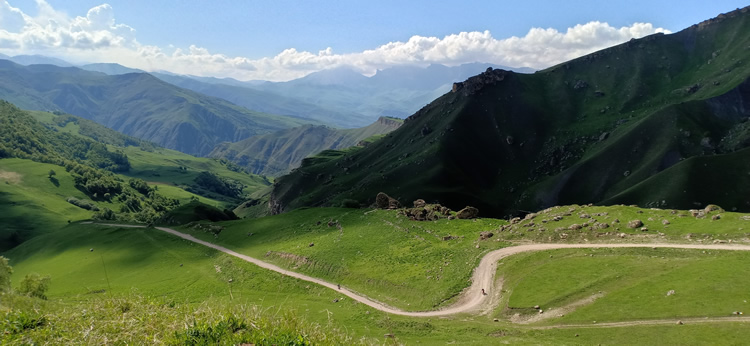
Day 4 - Kurdzhinovo - Dombay
Today we will start driving a tough winding drive of 17 kilometers to the village of Arkhyz. Arkhyz was founded in 1923 and is located in the valley of the Bolshoy Zelenchuk River, in the Republic of Karachay - Cherkessia. Here we will have lunch and visit the Astrophysical Observatory of the Russian Academy of Sciences (SAO RAS) where there is a giant telescope.
Then we drive along beautiful high mountains towards Dombay. The road rises to 3012 meters. We see the mountains Ine, Sofruju, Belalakaya, Alibek, Sulahat and we have a beautiful view of the majestic peaks of the highest mountain in this area the Dombay-Ulgen at 4046 meters. That means "killed bison" in the Karachai language. At the end of the day we arrive in picturesque Dombay. This ski resort is located in the forest at the junction of the three major gorges Alibek, Amanauz and Dombay-Ulgen. We spend the night between these beautiful mountains.
Day 5 - Dombay - Kislovodsk
Today we will go over the Gum-Bashi pass to the breathtaking Bermamyt Plateau is. This is one of the most panoramic places of the Karachay-Cherkessia Republic. It is located on the northern slope of the Greater Caucasus. The main part of the plateau - Bolsjoj (Big) Bermamyt - lies at an altitude of 2591 meters .. South is Maly, the small Bermamyt at 2643 meters. This is the highest point of the ridge. The name Maly was given because of the smaller area occupied by the area. It is also the southern boundary of the region of the Caucasian mineral waters. This place is perfect for landscape photography. Beautiful cliffs, slopes of lowlands, grass covered with alpine flowers, beautiful morning and evening mist, beautiful mountains and often jagged clouds. If the sky is clear we can see the snow-covered peaks of the Greater Caucasus and Mount Elbrus.
We proceed to Kislovodsk and we will check into our hotel. Kislovodsk is a well-known spa and there is mineral water. Here are 7 water sources. If you want you can take a walk through the largest National Park in Europe. or visit the Narzan gallery. where you can drink mineral water and the water sources are made of beautiful marble.
Day 6 - Kislovodsk - Elbrus
After breakfast we go to Azau, a ski resort, and drive along the northernmost foothills of the stratovolcano Elbrus. At 5642 meters, it is the highest mountain in Europe, Russia and the Caucasus. A lot of bends during the descent to the village of Terskol. From here we have a view of the mountain Cheget. You can get to 3780 meters in 3 stages with the old open cable car and / or modern lift and then climb further to 4050 meters. We can ee the peaks of the Elbrus and the glacier "Seven". We also see the Baksan gorge and the mountain lake Donguzorunkel. Tonight we will stay in Elbrus.
Day 7 - Elbrus - Fiagdon
We will leave early in the morning today and drive via Azau to Upper Fiagdon. This is located in the Kurtat Valley on the Fiagdon River. We drive on mountain roads, winding along rivers and ravines. The ridge road is mostly gravel and mostly off-road. We visit the National Park of Alanya and enjoy beautiful views over the ridge of Caucasus. The highest point in Alanya National Park is Mount Oeilpata 4646 meters and the lowest point in the valley is Oeroech at 800 meters. In the higher parts, the National Park is largely covered with glaciers, rocks and rubble. In the valleys to the north of the park are forests and grasslands. This National Park has more than 70 rivers and streams, mostly fed by glaciers. A fifth of the National park is covered with forest. Mammals such as the brown bear, wolf, pine marten, wild cat and ibex are found here. In addition, there are also many bird species.
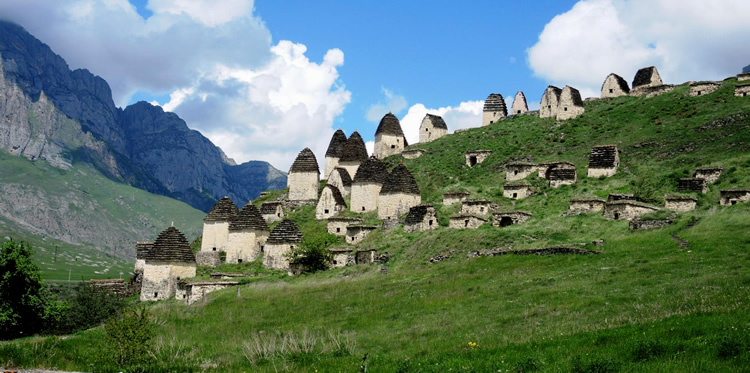
Day 8 - Fiagdon - Grozny
From Fiagdon we go to one of the most mysterious places in Russia, the city of the dead Dargavs. The remains of more than 10,000 people - bones, skulls and whole mummies - are housed in the 97 crypt houses. The impressive city of Dargavs consists of a large number of mausoleums and beautiful surroundings. The cemetery is located on a hillside overlooking the green Fiagdon River valley, with several cliffs and 4000m peaks. The cemetery has nearly 100 old stone burial vaults where people who lived in the valley buried their loved ones along with their clothes and belongings. The grooves look like huts with curved roofs that point upwards. A typical example of Nakh architecture, with some crypts that are 2 to 4 floors high. There are many myths and legends about this place. In the past, locals tried to avoid this place because it was believed that whoever went walking here would never come back alive. Even today few tourists come here, although this is not so much due to the curse that would hang here, but because this place is difficult to reach.
Then we drive to the Karmadon gorge to the place where the famous Russian actor Sergei Bodrov died September 20, 2002 on the second movie day of "the Messenger". We see the watchtowers and the remains of an avalanche, the top of Mount Kazbek at 5047 meters. This ride on the road called "miltarian Georgian road" is about a pass at 2300 meter.
Next we go to Beslan where on September 1, 2004 Chechen militants took over 1200 people hostage in a school. It ended in bloodshed with hundreds of deaths three days later, the majority of those killed were children. This was one of the worst terrorist attacks in Russian history. Today we finish in Grozny with dinner in the restaurant and an evening walk.
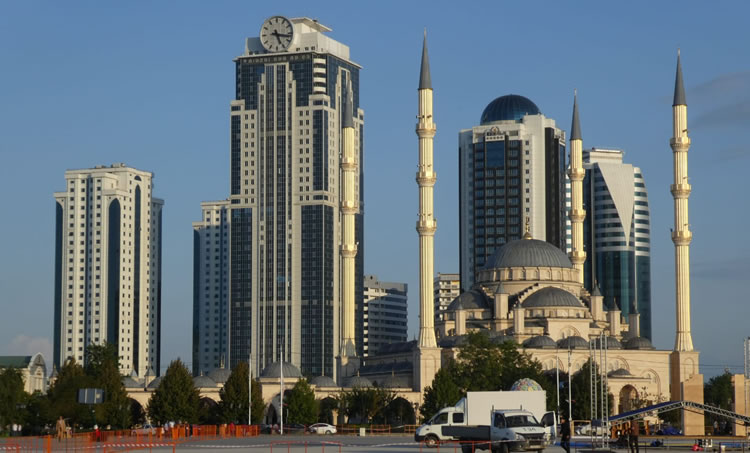
Day 9 - Grozny - stay
Today you will visit the capital of the Russian republic of Chechnya: Grozny.
After the Second Chechen War in 2002, abandoned apartment blocks and houses were demolished and replaced by new buildings. We visit the Putin Avenue, Grozny is the city of flowers, the mosque "heart of Chechnya" is built after the model of the Blue Mosque from the old Constantinople. The building is distinguished by white marble splendor, luxury of painting and unique chandeliers. Grozny was established as a military base in 1818. When oil was discovered in the region in the early twentieth century, the city grew enormously. In the meantime, the oil fields are almost exhausted. But Chechnya remained important to the international oil industry because of a network of oil pipelines that converged in Grozny. The Baku-Novorossiisk link, which ran through Grozny, was one of the main pipelines for the Russian oil industry. The Northern Caucasus has been inhabited by the Chechens for thousands of years. The original hill tribe called themselves Nokhchi. This was probably a reference to an ancient Chechen tribe, Nokhchmekhkakhoi, who lived in the mountain region of Ichkeria, an area still considered to be the cradle of the Chechen clans. Many independence fighters find support in Wahabism (a strict reading of Islam that came from Saudi Arabia, among others). an area that is still considered as the cradle of the Chechen clans.
We will discover the Chechen cuisine tonight. The basis of Chechen dishes consists of meat, leek, cheese, pumpkin and corn. The main components of the Chechen dishes are spicy herbs, onion, garlic, pepper and thyme. Chechen cuisine is known for its rich dishes and is also typically easy to prepare and easy to digest.
Day 10 - Grozny - Chokh
We will drive back from the valley into the mountains and we will have lunch on the border of Chechnya and Dagestan at Lake Kazenoy-Am. This is the largest and deepest lake in the North Caucasus and is located at an altitude of 1869 meters between the Andiyskiy Khrebet Mountains. The lake is home to a rare trout called the Salmo Ezenami. We will also drive along beautiful waterfalls. Then we continue to Chokh, the most beautiful mountain village in Dagestan. People have lived here since the Neolithic Age. Chokh is an open-air architectural museum. We spend the night in a unique guest house all in one room. This ethnic house is decorated in traditional mountain style with all elements of ethnic culture,
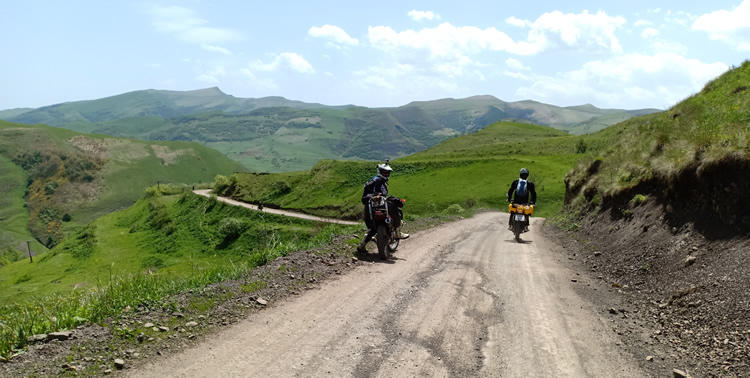
Day 11 - Chokh - Kubachi
Today we are going to the deserted mountain village of Gamsol. It is located on top of a mountain, at an altitude of about 1500 meters above sea level. This remote village is surrounded by cliffs and steep slopes. The word Gamsutl is translated from the Avar and means "at the foot of the fortress of Khan".
Next we will drive to the underground caves and waterfall in a gorge of the Saltinka River. This narrow gorge leads to a cascading waterfall, which eventually forms a water cave. This waterfall is a wonder of nature. The day ends in the village of Kubachi and is located at an altitude of 2000 meters. Here the population carves world famous ornaments and silver ornaments. All Kubatsi carry out the same craft wherever they live.
Kubachi, the name of the village, the inhabitants and the mountain on which they live. It originates from Turkish and means 'weapon makers'. Gold and silver daggers, swords and armor from this village were in demand among all nations that had passed through them for the past 1,300 years: the Persians, the Mongols, the Ottomans and again the Persians. Their influence was never comprehensive, nor was that of the Russians who met fierce local resistance when this part of the Caucasus was conquered in the 19th century. But the strongest is the local identity. To maintain their craft, the girls of Kubachi are forbidden to marry a young man from another village. Biologists who examined the genetic makeup of the village concluded that in the past nine generations, only ten Kubachi have been married 'outside the village' - nine men and one woman.
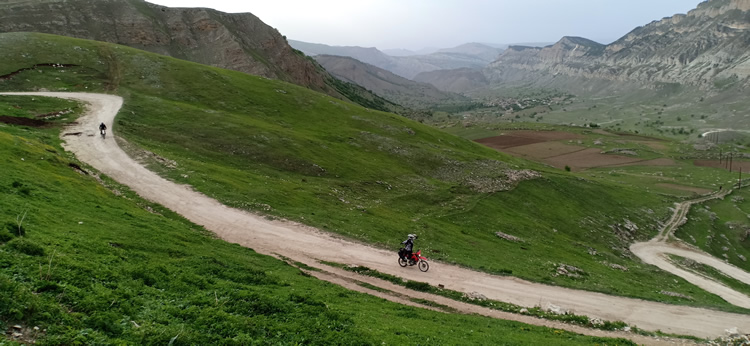
Day 12 - Kubachi - Derbent
We are going to visit a jeweler to see how jewelry is made. Then we drive to the Huczynski waterfall. It falls down in two stages, the first part is at a height of 3 meters and the higher part is at about 15 meters. At the foot is a small pond with clean water where we can swim. Then we drive on asphalt to Derbent, the southernmost city in Russia.
Derbent fortress is included in the UNESCO World Heritage List. This fort is almost 2500 years old, making it the only remaining Sassanid fort. The old city is surrounded by a double wall 3600 m long - a monument of ancient Persian fortress architecture. Tonight we walk through the streets of old Derbent and eat in a restaurant on the Caspian sea.
In Derbent is the old citadel Naryn-Kala. This fort is on the UNESCO list and is almost 2500 years old. This makes it the only remaining Sassanid fortress. The citadel is 45,000 m² in size. It was once founded on the northern border of the Persian regions by Yazdegerd as a city fortress. The fortress was to guard this important passage through the Caucasus against attacks by the Chazars and the Huns. The walls of the fort are 4 meters thick and 18 meters high. You can also visit the remains of the Caucasus Wall. These used to run into the sea and formed the harbor. Much of the walls and a number of watchtowers have been reasonably preserved. The wall is also known as the Alexander Wall, which closed off the narrow passage of the Iron Gate.
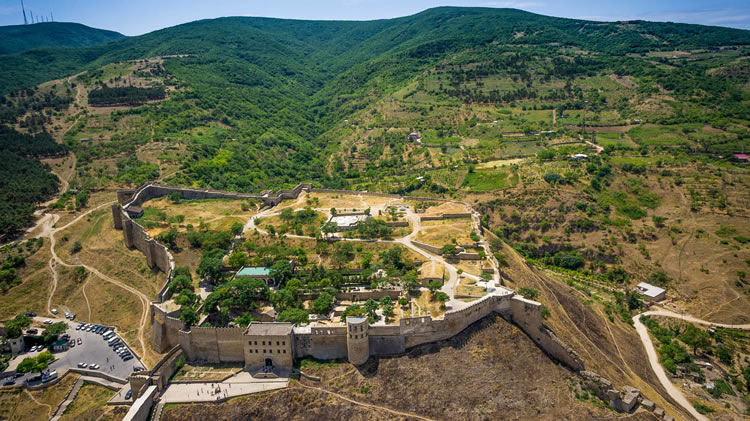
Day 13 - Derbent - Makhachkala
From Derbent we drive along the Caspian Sea to the capital of the "land of the mountains" Dagestan, Makhachkala. This name is difficult to read, even more difficult to pronounce. We spend the last 2 nights in the Talgi sanatorium where you can bath in therapeutic hydrogen sulfide. The first evening we will have a karaoke disco, dancing and dinner in the sanatorium.
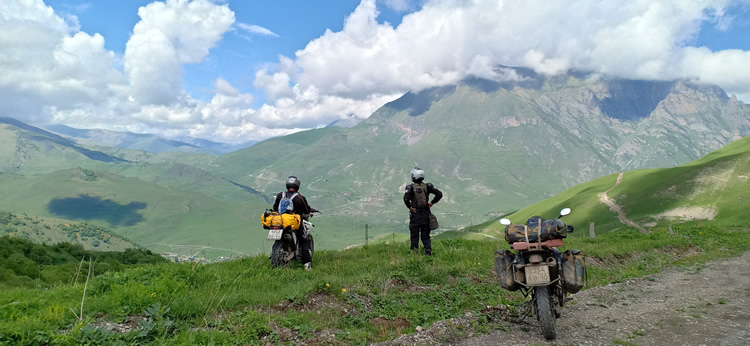
Day 14 - Makhachkala - stay - daytrip
From Makhachkala we will make a day trip to Sulakskiy Kan'on which is1920 meters the deepest ravine in Europe. This is deeper than the Grand Canyon in the United States. Then we see yet another mystery of nature. The 50-meter high sand dune Arkham Asylum is located between the mountains of the Caucasus and the Caspian Sea. There is no desert around.
Finally we visit the city of Makhachkala. The Highlanders called the city Anzhi-Kala - “pearl city”. The “pearls” of architecture are the State Building, the Rostov University site and the Kumyk Theatrer. Other attractions include the City Garden, Friendship Square, the monument to the Russian teacher, the Juma Mosque and the Holy Dormition Cathedral. The pride and beauty of the inhabitants of Makhachkala is Mount Tarki-Tau. According to the legend, there was the capital of the Khazar Kaganate here in the VII century, and to this day the lookout point and some old buildings have been preserved.
This is the end of our Trans-Caucasian journey. Our farewell dinner is in a traditional restaurant along the shore of the gray Caspian sea with Dagestan brandy.
Day 15 - Makhachkala - departure
We probably fly to Moscow and make a stopover to fly home.
-
Tourdetails
Tourcode:RGACategory:AdventureGroup size:4 - 10Days:15Price:From $3.295,-
-
departures
-
Routemap
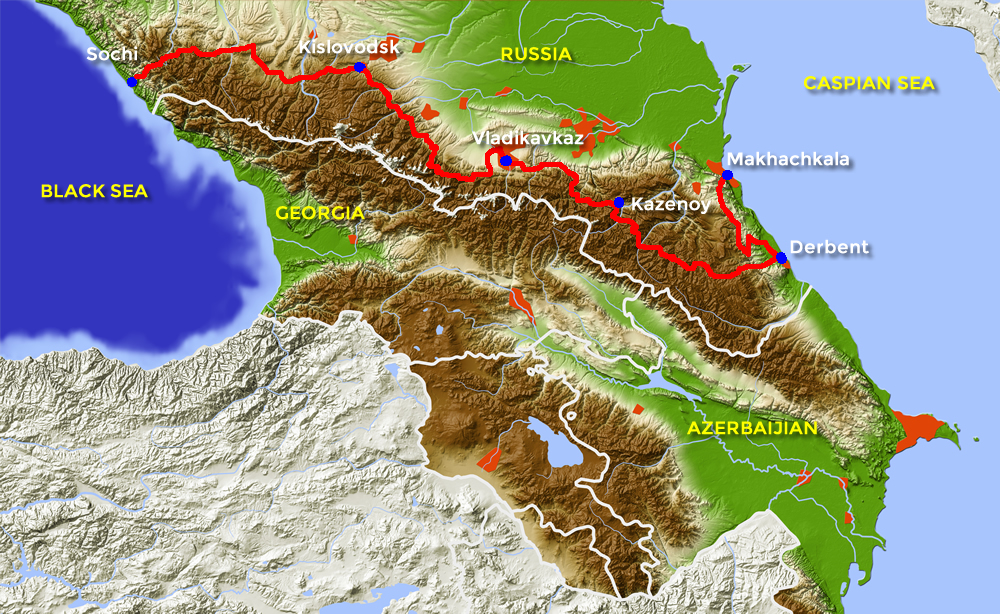

-
Video


